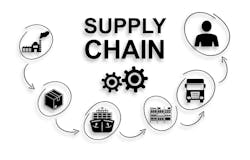What’s on Tap for Supply Chains for 2021?
Download this article in PDF format.
As the curtain falls on a year of unprecedented disruption, Tradeshift asked several of its senior leaders to share their views on the key issues that will shape decision-making across global supply chains in 2021. Here are their top five predictions on the challenges organizations will need to address as they look to reshape supply chains and build long-term business resilience during the year ahead.
1. Kiss paper and manual processes goodbye. Lockdown restrictions revealed the challenges and inefficiencies which come from the antiquated, paper-based processes most buyer and supplier relationships relied on pre-COVID. Organizations that have not already digitized these processes will be placing this transition high on the priority list for 2021. “Digitizing the connection between buyers and sellers will play a key role in helping businesses build resilience to future shocks,” says Raphael Bres, chief product officer, “while also enabling more effective risk mapping and giving organizations greater flexibility to identify and onboard alternative suppliers should a key link in the chain come under pressure.”
2. Embrace the diversified supply chain. Pre-COVID, businesses already realized that weathering different types of storms (e.g., trade wars and broader geopolitical and environmental threats) required flexible supply. The pandemic simply crystallized these challenges and gave them more urgency. “Businesses that typically relied on single-source suppliers for key components will be looking to spread the risk over multiple suppliers in different locations,” says Mikkel Hippe Brun, co-founder and senior VP, APAC. “That adds a certain amount of cost to the product since you’re transforming business models away from simple bulk purchasing.”
He says companies also need to consider how their products are designed and built. For example, they have to be able to accommodate variations in terms of the sub-components they are using from a variety of suppliers, which adds an element of complexity. “Organizations will need to consider whether they absorb the cost of resilience, pass it on to the customer or look for other ways to increase efficiency,” Brun adds, “such as through the use of automation and other technologies including 3D printing.”
3. Find new ways to build financial resilience into the supply chain. Ensuring the financial resilience of the supply chain will be paramount in 2021. While COVID vaccines are emerging, Gert Sylvest, co-founder and GM at Tradeshift Frontiers, says these aren’t going to be quick fixes. The most important practical measure that companies can take in 2021 is to ensure the financial resilience of their supply chain. “This means regaining control over credit lines for themselves, and to offer the same to their suppliers,” says Sylvest. “Companies that are part of digital supply chains in 2021 have access to new generations of early payment solutions that are far superior to traditional [methods] in terms of availability, scope and cost.”
4. Brace for more regulatory scrutiny. COVID put a spotlight on how a sudden spike in demand for certain goods can lead to unfair practices and abuse. The scramble for PPE is a good example. “Governments must shoulder some of the blame for running down stocks of equipment,” says Bres. “Just as shocking, however, was the rampant profiteering taking place on everything from masks to hand sanitizer.” Expect regulators to take a tougher stance to protect against this kind of price gouging, and to introduce more formalized restrictions to keep suppliers from breaching existing commercial agreements in order to sell vital equipment to the highest bidder, Bres adds.
5. China will decouple more and more from the Western world. “We have a tendency in the West to talk about a decoupling with China, but we forget that China is also decoupling with us,” Christian Lanng, CEO and chairman, points out. “That means an increased focus on the domestic economy and local trading partners, while the West becomes less relevant as a trading partner.” He says that rather than blaming China for the current trade turmoil, the West should “really be paying attention to its own loss of manufacturing and technology, which could well prevent us from competing in the future.”
About the Author

Bridget McCrea
Contributing Writer | Supply Chain Connect
Bridget McCrea is a freelance writer who covers business and technology for various publications.







